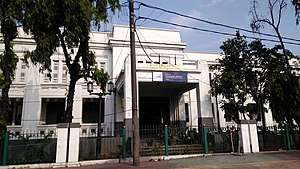Tanjung Priuk railway station
Tanjung Priuk Station (TPK), is a railway station in Tanjung Priok, Tanjung Priok, North Jakarta. It is located across the Tanjung Priok Port, which is the main port of Jakarta. This station is one of the oldest in Jakarta and the biggest station built during the Dutch East Indies era. It is included in the list of heritage building by the government of Jakarta.
 Tanjung Priuk Station, 2019. | |||||||||||
| Location | Jalan Taman Stasiun Tanjung Priok, Tanjung Priok, Tanjung Priok, North Jakarta 14310 Jakarta Indonesia | ||||||||||
| Coordinates | 6.1111°S 106.8808°E | ||||||||||
| Elevation | +4 m (13 ft) | ||||||||||
| Owned by | Kereta Api Indonesia | ||||||||||
| Operated by | Kereta Api Indonesia Kereta Commuter Indonesia | ||||||||||
| Line(s) |
| ||||||||||
| Platforms | 4 bay platforms | ||||||||||
| Tracks | 8 | ||||||||||
| Connections | |||||||||||
| Construction | |||||||||||
| Structure type | Ground | ||||||||||
| Parking | Available | ||||||||||
| Disabled access | Available | ||||||||||
| Other information | |||||||||||
| Station code | TPK | ||||||||||
| History | |||||||||||
| Opened | 2 November 1885[1] 28 April 2009 (reopened)[2][3] | ||||||||||
| Rebuilt | 6 April 1925[4] | ||||||||||
| Electrified | 6 April 1925[5] | ||||||||||
| Services | |||||||||||
| |||||||||||
| Location | |||||||||||
 Tanjung Priuk Station Location in Jakarta | |||||||||||
History
The history of Tanjung Priuk station is intertwined with the port of Tanjung Priok, the main port and gateway to Batavia and thereby of the entire Dutch East Indies.
The port was built in 1877 in response to the increased maritime traffic accompanying the opening of the Suez Canal. Since Tanjung Priok is situated further away from Batavia than the old port of Sunda Kelapa, a railway was constructed linking Tanjung Priok to the city of Batavia in the southwest. This would provide a safe and comfortable means of transportation in the swampy area.[6]
The first station opened in 1885 on the quay immediately next to the first harbour. The second and current station was built a kilometer southward in 1914. The Art Deco building was designed by C.W. Koch, head engineer of the Staatsspoorwegen (SS). 1700 workers, including 130 Europeans, were tasked with constructing the station and the station was completed on 6 April 1925.
The station ceased to operate passenger trains between 2000 and 2009, during which the station was used for shunting freight trains. The station was renovated and reopened for passenger services on 28 April 2009.[2][3]
Services
So far only a few long distance economy class trains depart/terminate at this station. Starting from 1 November 2014, Tanjung Priuk Station only serves freight trains heading from/to Tanjung Priok Port. All passenger trains that used to terminate here were rerouted to Pasar Senen.[7]
On 21 December 2015, the pink line to Jakarta Kota railway station was reopened, after being inactive for years.[8]
Public transport
- TransJakarta Corridor 10
- TransJakarta Corridor 12
References
- Perquin, B.L.M.C. (1921). Nederlandsch Indische staatsspooren tramwegen. Bureau Industria.
- "Cita-cita, Bikin Statiun Pintar KA". www.jpnn.com (in Indonesian). 28 April 2009. Retrieved 23 June 2020.
- Mediatama, Grahanusa (28 April 2009). "Presiden Resmikan Terminal Tiga Soekarno Hatta dan Rehabilitasi Stasiun Tanjung Priuk". kontan.co.id (in Indonesian). Retrieved 23 June 2020.
- Reitsma, S.A. (1925). Boekoe peringetan dari Staatsspoor-en-Tramwegen di Hindia Belanda. Weltevreden: Topografische Inrichting.
- "Awal Mula Jalur Layang Kereta di Indonesia - Historia" (in Indonesian). Hendaru Tri Hanggoro.
- "Tanjung Priok, Stasiun", Jakarta.go.id, archived from the original on 23 February 2015
- Rachman, Taufik (13 November 2014), "Stasiun Tanjung Priok Fokus Kereta Barang", Republika, retrieved 17 January 2017
- Agustinus, Michael (21 December 2015), "KRL Kota-Tanjung Priok 'Hidup Lagi'", Detik.com, retrieved 17 January 2017
External links

| Preceding station | Kereta Api Indonesia | Following station | ||
|---|---|---|---|---|
| Ancol towards Jakarta Kota |
Jakarta Railway JAKK–TPK |
Terminus |